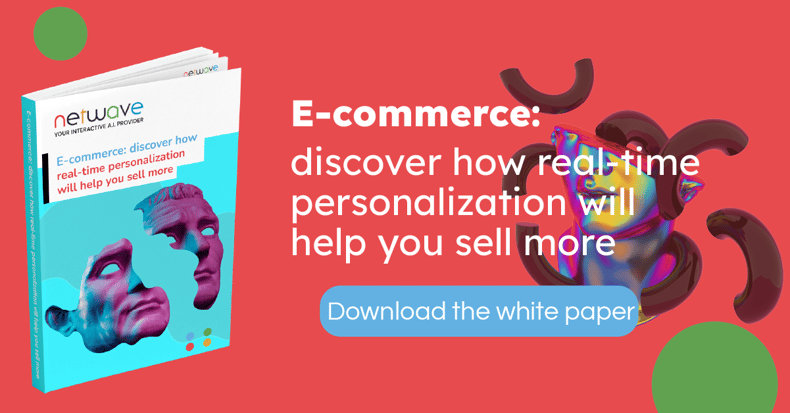
Making product recommendations on your e-commerce site: yes, but how? It is not always easy to see clearly among all the personalisation solutions available on the market. Although your choice depends mainly on your objectives and specificities, certain functionalities remain essential for relevant recommendations. Let's find out!
Product recommendation: why and how?
Product recommendation consists of recommending items to a visitor browsing your e-commerce site. The recommended items can be of several types: products similar to the product being viewed, complementary products (cross-selling), products from a slightly higher range (up-selling), etc.
The purpose of the product recommendations is twofold:
- Improve the customer experience by providing advice, just as a salesperson would in a shop.
- Make more sales by presenting exciting items to the visitor.
Read also: 6 good reasons to adopt a real-time personalisation solution on your e-commerce site
Often, product recommendation is an automated process thanks to product recommendation engines. These marketing personalisation solutions can allow you to :
- Save time in the commercial animation of your e-commerce site.
- Increase your turnover/visit.
- Increase the relevance of your product recommendations.
- Increase your customer satisfaction rate.
However, many product recommendation tools exist..., and not all are equal!
Here are the 5 key features of a personalisation solution to make the right choice for a relevant and effective product recommendation.
Personalisation solution: the 5 essential features for a relevant product recommendation
Product recommendation #1: Data collection
What is the primary function of your personalisation solution? To understand your visitors. The product recommendation tool you choose must be able to give you an accurate description of each of your visitors.
- How many times has this visitor been to your e-commerce site?
- What product categories are they interested in?
- How sensitive is it to customer reviews?
- Does his visit seem decided or undecided?
- What price range does it consult?
- How long does it stay on a page?
Individually, the answers to these questions do not allow you to conclude the visitor's needs. Together, they form a meaningful situation that gives you precise indications of what each of your visitors is looking for. Especially when compared to the identical situations that the system keeps in memory.
Your personalisation solution must integrate numerous trackers that allow you to consider your visitors' context, behaviour, and psychology. If this is not the case, your product recommendation will not be relevant and only provide average and irrelevant advice to your visitors.
Most solutions make do with a few dozen trackers, exclusively focused on context and behaviour. Netwave integrates 232 trackers that consider context, behaviour, and psychology to ensure real granularity in identifying situations. The result: 85,000 cases identified for every 1 million visits, of which 16,000 are commercially exploitable!
Read also: Product recommendation: 5 tips for making relevant suggestions to the consumer
Product recommendation #2: The creation of real-time interaction rules
To offer a tailor-made service to your visitors, your product recommendation engine must exploit their browsing data in real-time. Each action must be considered: the product recommendation rules must be recalculated and updated in real-time.
Otherwise, your personalisation tool will simply arbitrate between a few dozen pre-configured interaction scenarios and will not adapt to the actual situation of your visitors and its evolution. The challenge here is to identify the visitor's situation at each click in real-time and not to link it to a predefined segment. This makes it possible to offer the recommendations that have been most effective with the last visitors who are most like them and to adapt the rules applied to each new click.
Product recommendation #3: Distance calculation
Directly linked to the previous functionality, the distance calculation allows to determine a group of last visits like the current one in real-time. It allows for real-time processing. In concrete terms, it consists of measuring the distance between the current and previous visits using a valuation of each tracker. The most distant visits are not used as a reference base for generating personalised insight.
While machine learning or deep learning-based personalisation tools link the visitor to a predefined and fixed segment, those using distance calculation identify the situation and generate the recommendation in real-time. This ensures that your product recommendations correspond 1/ to the actual situation of your visitor at a given moment 2/ to the trend in terms of consumption. You can, therefore, provide them with advice adapted to their needs.
Product recommendation #4: The ability to communicate your business strategy to your recommendation solution
It is indeed crucial for you to communicate your business strategy as you would to your sales team.
Discounter or high-end, generalist or specialist, 100% e-merchant, marketplace or hybrid, your commercial strategy will not be identical, and you must be able to impose it on your tool.
Give priority to recommending products on special offer when you are in a clearance period, products that generate the highest margin for you, limit cross-selling to the merchant that is the main purchase so as not to increase shipping costs, etc. You should be able to carry these elements quickly, in a few clicks, in a few seconds. If not :
- the tool will, at worst, recommend what sells best on your site, all visits combined, and as by hypothesis, even you need to destock what sells less well than you had planned...
- at best will require significant effort to set up manual rules.
Product recommendation #5: Manual setting of specific rules
An indispensable functionality remains the manual setting of rules. You must be able to take control of the product recommendations made by the tool and impose a particular rule corresponding to an individual situation (for example, a specific agreement with a supplier) by a simple "If...then" setting.
Key point: do not abuse manual rules and reserve them for a few cases. They are cumbersome and require time-consuming monitoring to avoid becoming unproductive or counterproductive. In any case, limit the time they are applied to avoid ending up with hundreds of rules for which you no longer know who set them up or why.
Netwave: a new generation personalisation solution for efficient product recommendations
Netwave's next-generation Artificial Intelligence technology makes personalised product recommendations to visitors to your e-commerce site.
Netwave's approach is first and foremost to understand your visitors, in real-time, without trying to pin them down to a predefined segment, thanks to the weak signals they leave while browsing. In addition to improving the user experience, Netwave makes product recommendations that will maximise your chances of conversion!
In short, Netwave is :
- 232 trackers to capture the context, behaviour and psychology of your visitors and make your visitors' browsing experience commercially meaningful.
- A processor that recalculates the situation with each piece of data received to ensure the relevance of your recommendations.
- 85,000 situations are identified for every 1 million visits to ensure that all your visitors are worked on individually.
- Communicate your sales AI policy to ensure it will work for your visitor's interest and you.
- Supervised mode operation to generate manual rules in a few clicks.



